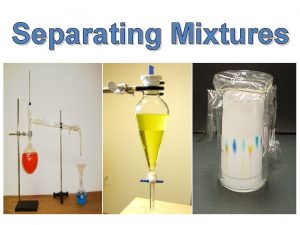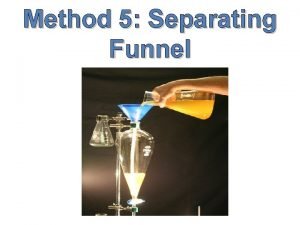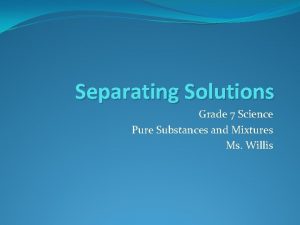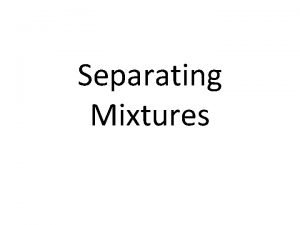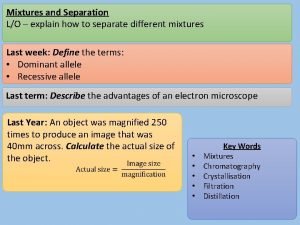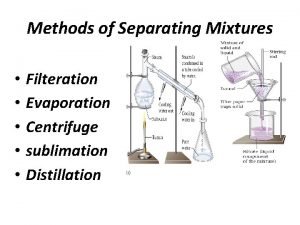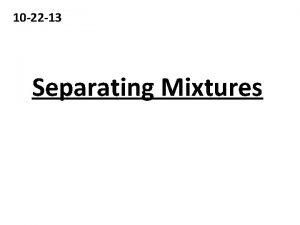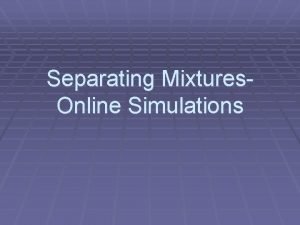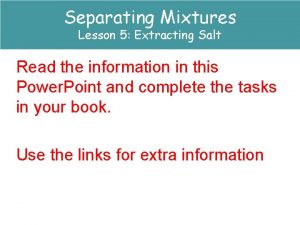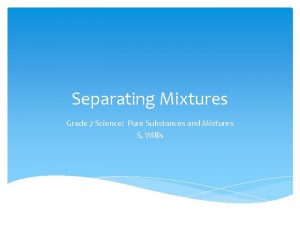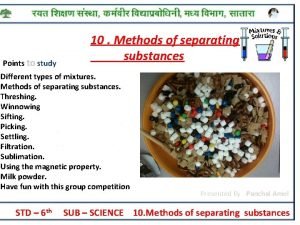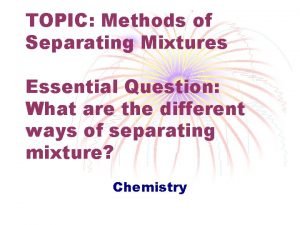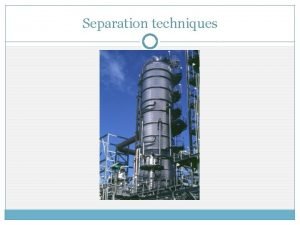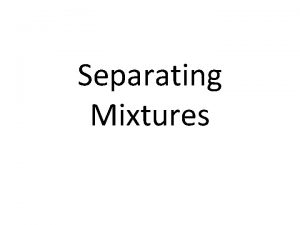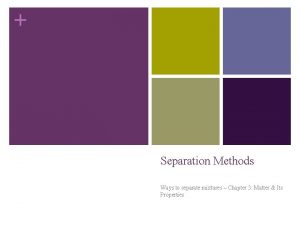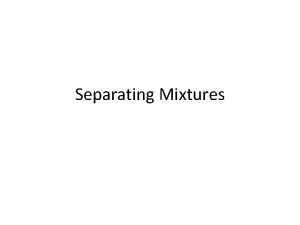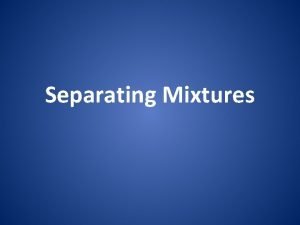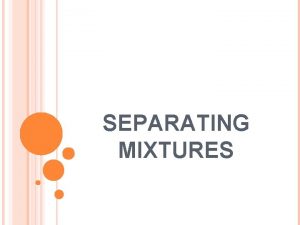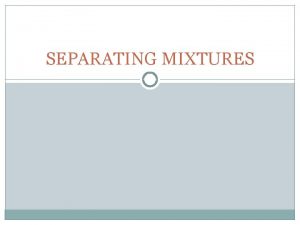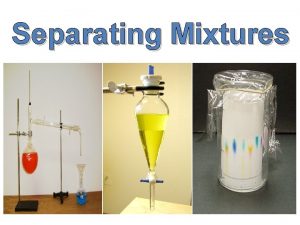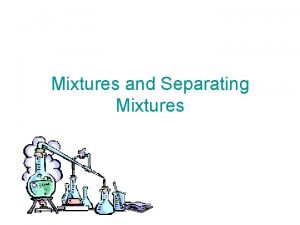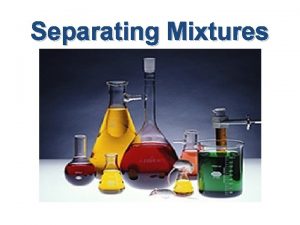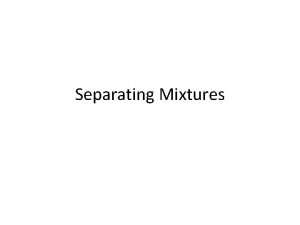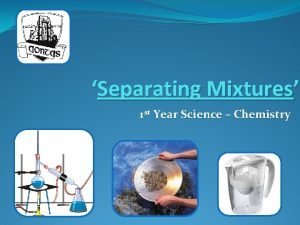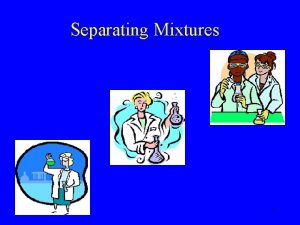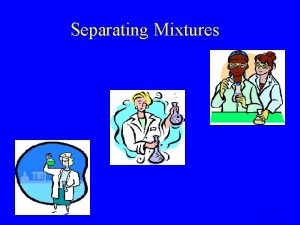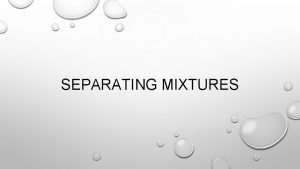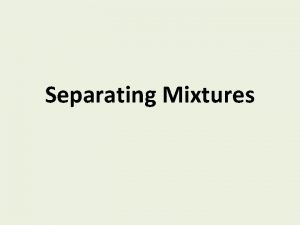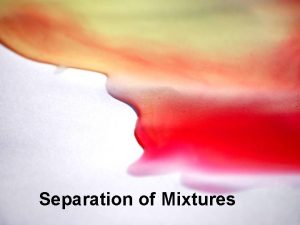Separating Mixtures Why is it important to separate


















- Slides: 18

Separating Mixtures

Why is it important to separate mixtures? Since mixtures form part of our everyday life, the separation of these mixtures into their component parts is important. Examples: purification of drinking water, making of filter coffee. If you were stuck on a desert island without any drinking water your knowledge of separating mixtures could help you to make pure water from sea water.

What are mixtures? Mixtures are a type of matter where component parts can be separated by physical means.

How do we know which separation method to choose? The method by which a mixture can be separated into its component parts is determined by the physical properties of these parts, e. g. particle size, boiling point, solubility.

Methods of Separating Mixtures

Method 1: Filtration

When is filtration used? Filtration is used to separate a mixture of a solid and a liquid where the solid does not dissolve in the liquid. The mixture is called a suspension.

Filtration Apparatus

Filter Paper Filtration makes use of filter paper to separate the solid from the liquid. Question: Why is the filter paper used?

How does filter paper work? The filter paper works as a sieve keeping back the solid particles. These particles are too big to pass through the filter paper, whereas the liquid particles are small enough to pass through the filter paper.

Filtrate & Residue The part of the mixture that stays behind on the filter paper is known as the residue and the part that passes through the filter paper is known as the filtrate. Questions: 1. What is the colour of the reside below? 2. What is the colour of the filtrate below?

Everyday Examples of Filtration 1. Filtration is one of the steps in the purification of drinking water. Most simple water purification devices use filtration as their main method of purification, separating the solid impurities from the water.

Everyday Examples of Filtration 2. Coffee machines make use of filters, in the form of a filter paper to separate the coffee granules from the liquid.

Method 2: Evaporation

When is evaporation used? Evaporation is used to separate a solution of a solid dissolved in a liquid, but it only allows the solid to be collected.

Evaporation Apparatus

What happens during evaporation? During evaporation, the solution is boiled allowing the liquid to vaporise into the air. The solute will be left behind in the container.

Temperature for evaporation Evaporation occurs at all temperatures, not just the boiling point of the solvent, so if a beaker containing a solution of salt dissolved in water is left for a while it will eventually contain only salt, as the water will have evaporated.
 Importance of separating mixtures
Importance of separating mixtures Principle of paper chromatography
Principle of paper chromatography Separating solutions
Separating solutions Filtration separating mixtures examples
Filtration separating mixtures examples 5 examples of separating mixtures using magnet
5 examples of separating mixtures using magnet Natural science grade 7 lesson plans term 2
Natural science grade 7 lesson plans term 2 Chromatography separating mixtures
Chromatography separating mixtures Sublimation
Sublimation Separating mixtures 5th grade
Separating mixtures 5th grade Separation techniques gcse
Separation techniques gcse Fossweb mixtures and solutions
Fossweb mixtures and solutions Chemistry separating mixtures worksheet
Chemistry separating mixtures worksheet Separating mechanical mixtures
Separating mechanical mixtures 10 methods of separating mixtures
10 methods of separating mixtures Centrifuge separating mixtures
Centrifuge separating mixtures Objectives in separating mixtures
Objectives in separating mixtures Example of magnetism in separating mixtures
Example of magnetism in separating mixtures 14. separating mixtures of liquids.
14. separating mixtures of liquids. Crystallization
Crystallization
